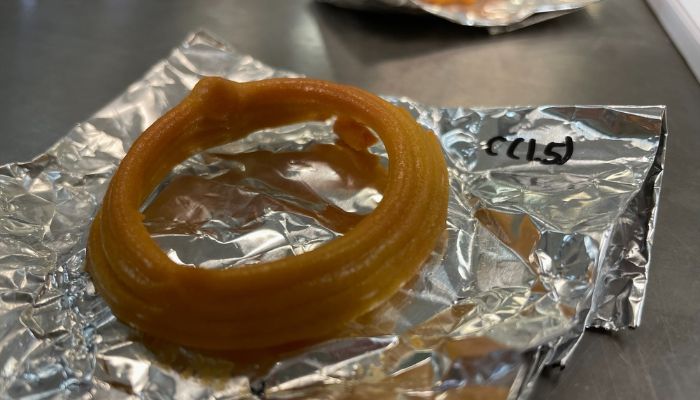3D Printed Plant-Based Calamari Set To Make Waves

Humanity’s appetite for seafood is vast and worldwide. An average person eats over 45 pounds of fish per year, but overfishing, accessibility, affordability, and increasing ocean contamination with dangerous materials such as microplastics and heavy metals have pushed pioneers to seek out familiar flavors in new places. Demand for more plant-based seafood alternatives has steadily risen over the past few years, seeing the introduction of 3D printed, plant-based fish substitutes such as salmon, tuna, and even eel. In most recent news, researchers at the University of Singapore have been working to add calamari rings to the menu next with the help of food-grade 3D printing using edible bioink.
Dr. Dejian Huang heads the team at the University of Singapore that is behind the research and creation of new 3D printed plant-based substitutes. The team has previously worked on salmon and shrimp alternatives and has now set its sights on the viability of plant-based calamari. Dr. Huang explains, “Plant-based seafood mimics are out there, but the ingredients don’t usually include protein. We wanted to make protein-based products that are nutritionally equivalent to or better than real seafood and address food sustainability”. As an early convert to plant-based meat substitutes might tell you, it can be difficult to nail the right balance of flavor and texture to closely resemble the properties of meat. The research team is therefore paying close attention to both in this vegan calamari by using a protein-based bioink made of microalgae and mung beans, mixed with omega-3 fatty acids. The bioink is then turned into a paste and then extruded by a food-grade 3D printer.

The first of the 3D printed calamari rings after being air fried (Photo Credits: Poornima Vijayan)
Algae has already proven to be a game-changing component in several fields, with promising characteristics for CO2 reduction and medical advances. Moreover, as a food source it requires far fewer resources than traditional agriculture. The University of Singapore team specifically chose microalgae for its protein density, environmental sustainability and slight fishy flavor which adds to the overall character of the faux calamari. Mung beans, the second protein, are also plentiful and readily available. An additional benefit? The excess material particularly from the manufacture of mung bean vermicelli or glass noodles can be used in bioink for 3D printed foods instead of becoming waste.
The use of algae based bioink provides producers with a cheaper, renewable, and environmentally friendly alternative to meat proteins and in the case of seafood, can provide consumers with fish or shellfish allergies the opportunity to enjoy it as well. Creating more versatile food choices like calamari also gives consumers the freedom to prepare it however they like, be it in the pan, oven, or fryer. Their end-goal includes creating a product that is capable of large-scale production, eventually reaching restaurant kitchens and supermarket shelves. After trying their first test sample cooked in an air fryer, the team is hopeful that more 3D printed alternatives to seafood such as calamari may begin commercial production in the next few years. For more information, you can read the full story HERE.
How would you serve up a plate of 3D printed calamari? Let us know in a comment below or on our LinkedIn, Facebook, and Twitter pages! Don’t forget to sign up for our free weekly Newsletter here, the latest 3D printing news straight to your inbox! You can also find all our videos on our YouTube channel.
*Cover Photo Credits: Nhobgood Nick Hobgood, Own work, CC BY-SA 3.0







There are so many players in the plant based 3d printed food industry. The taste can be replicated but the most important element is whether the consumer feels like they are eating the real item and that requires texture technologies that will be more important now that the taste can be duplicated. Texture is key.